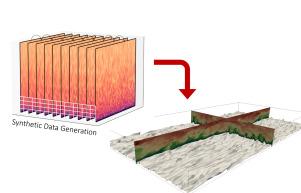Fake it till you make it: Synthetic turbulence to achieve swift converged turbulence statistics in a pressure-driven channel flow
IF 3
3区 工程技术
Q3 COMPUTER SCIENCE, INTERDISCIPLINARY APPLICATIONS
引用次数: 0
Abstract
In this study, we introduced a simple yet innovative application: the isotropic synthetic turbulence field generator (iSTFG), based on the synthetic turbulent inflow generator. The iSTFG leverages the homogeneity in the streamwise direction for channel flows and triggers turbulence to achieve statistically stationary flow conditions faster than standard community-used strategies. We compare this new method with two other well-established methods: linear and log-law profiles superposed with random noise and descending counter-rotating vortices. We find that iSTFG provides a computationally cheap and effective way to reduce simulation spin-up costs/time/emissions to achieve statistically stationary flow conditions when a precursor turbulent initial condition is unavailable. At a one-time cost between 1-10 Central Processing Unit (CPU) hour(s) to generate the synthetic turbulent initial condition based on the target friction Reynolds numbers (1 CPU hour - , 7 CPU hours - ), the flow achieves statistically stationary turbulent flow (SSTF) state within three eddy turnovers for all the parameters of interest in wall-bounded pressure-driven channel flow simulations when compared to other alternatives that can take more than ten eddy turnovers resulting in substantial savings in the computational cost. We also demonstrate that the transition and convergence to an SSTF state using conventional methods are sensitive to the computational domain size, while iSTFG is agnostic to the domain size. Furthermore, we explored the sensitivity of the iSTFG method to the non-dimensional integral length scale parameter and mismatch in reference and target input data to find iSTFG robust in such scenarios.

在压力驱动的通道流动中实现快速收敛湍流统计的合成湍流
在本研究中,我们介绍了一种简单而创新的应用:基于合成湍流流入发生器的各向同性合成湍流场发生器(iSTFG)。iSTFG利用通道流动在流向上的均匀性,触发湍流,比标准的社区使用策略更快地达到统计上稳定的流动条件。我们将这种新方法与另外两种成熟的方法进行了比较:线性和对数律曲线叠加随机噪声和下降的反向旋转涡。我们发现iSTFG提供了一种计算成本低且有效的方法,可以减少模拟自旋启动成本/时间/排放,从而在无法获得前驱湍流初始条件时实现统计平稳流动条件。基于目标摩擦雷诺数(1个CPU小时- Reτ=500, 7个CPU小时- Reτ=2000)生成合成湍流初始条件的一次性成本为1-10个CPU小时,在有壁压力驱动通道流动模拟中,对于所有感兴趣的参数,该流在3个涡转内达到统计平稳湍流(SSTF)状态,而其他替代方案可能需要10个以上的涡转,从而大大节省了计算成本。我们还证明了使用传统方法转换和收敛到SSTF状态对计算域大小敏感,而iSTFG对计算域大小不可知。此外,我们还探讨了iSTFG方法对无因次积分长度尺度参数和参考数据与目标输入数据不匹配的敏感性,以发现iSTFG方法在这种情况下具有鲁棒性。
本文章由计算机程序翻译,如有差异,请以英文原文为准。
求助全文
约1分钟内获得全文
求助全文
来源期刊

Computers & Fluids
物理-计算机:跨学科应用
CiteScore
5.30
自引率
7.10%
发文量
242
审稿时长
10.8 months
期刊介绍:
Computers & Fluids is multidisciplinary. The term ''fluid'' is interpreted in the broadest sense. Hydro- and aerodynamics, high-speed and physical gas dynamics, turbulence and flow stability, multiphase flow, rheology, tribology and fluid-structure interaction are all of interest, provided that computer technique plays a significant role in the associated studies or design methodology.
 求助内容:
求助内容: 应助结果提醒方式:
应助结果提醒方式:


